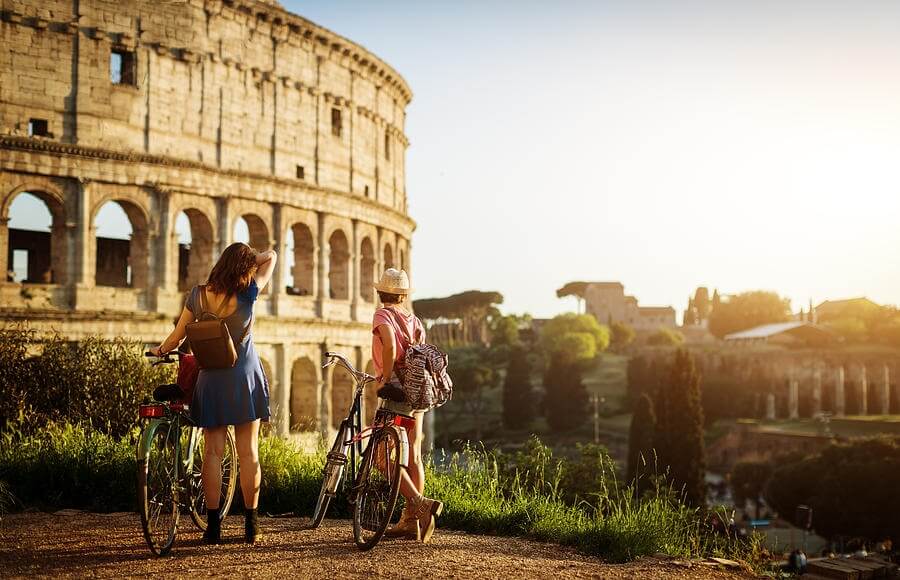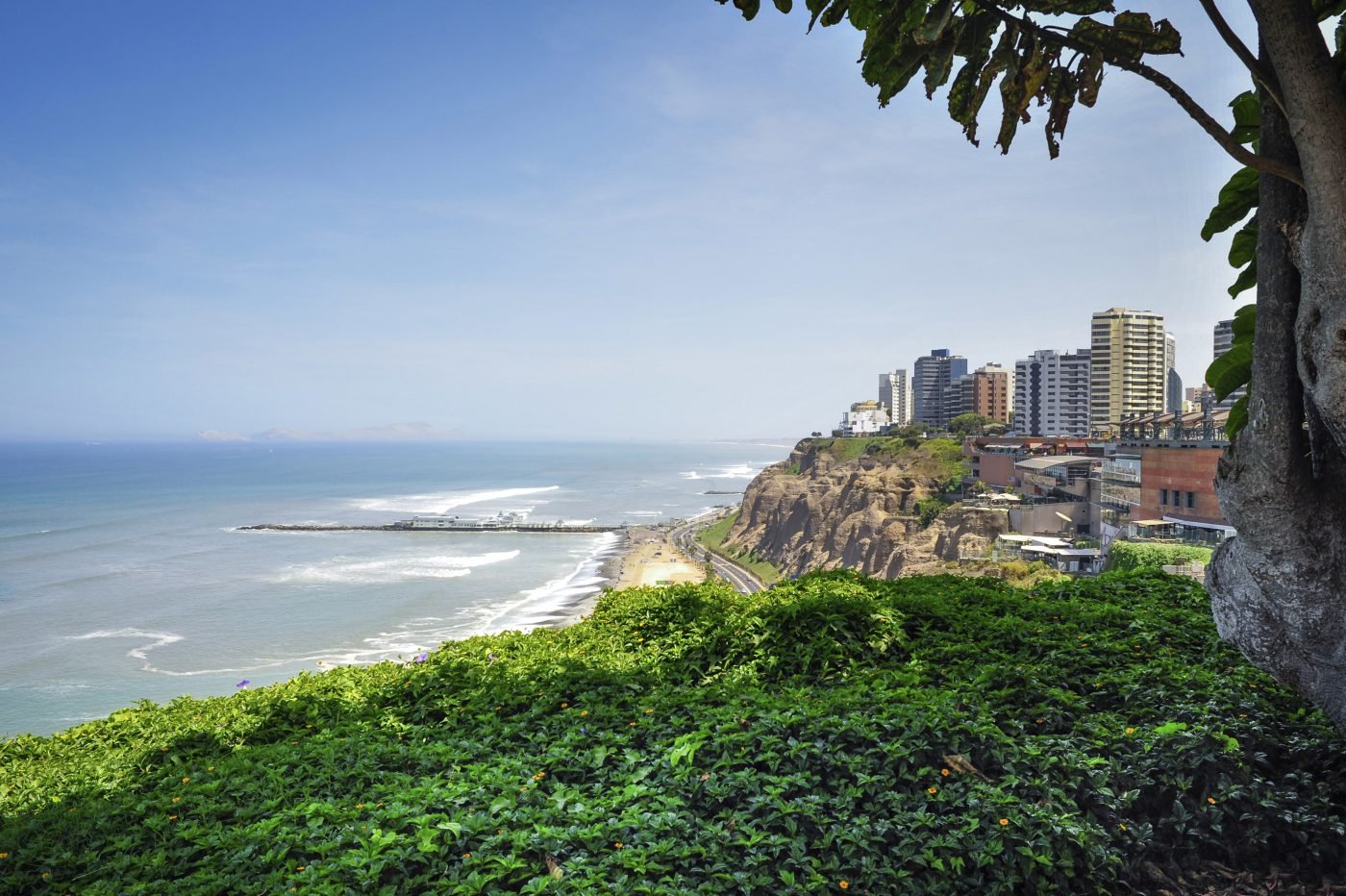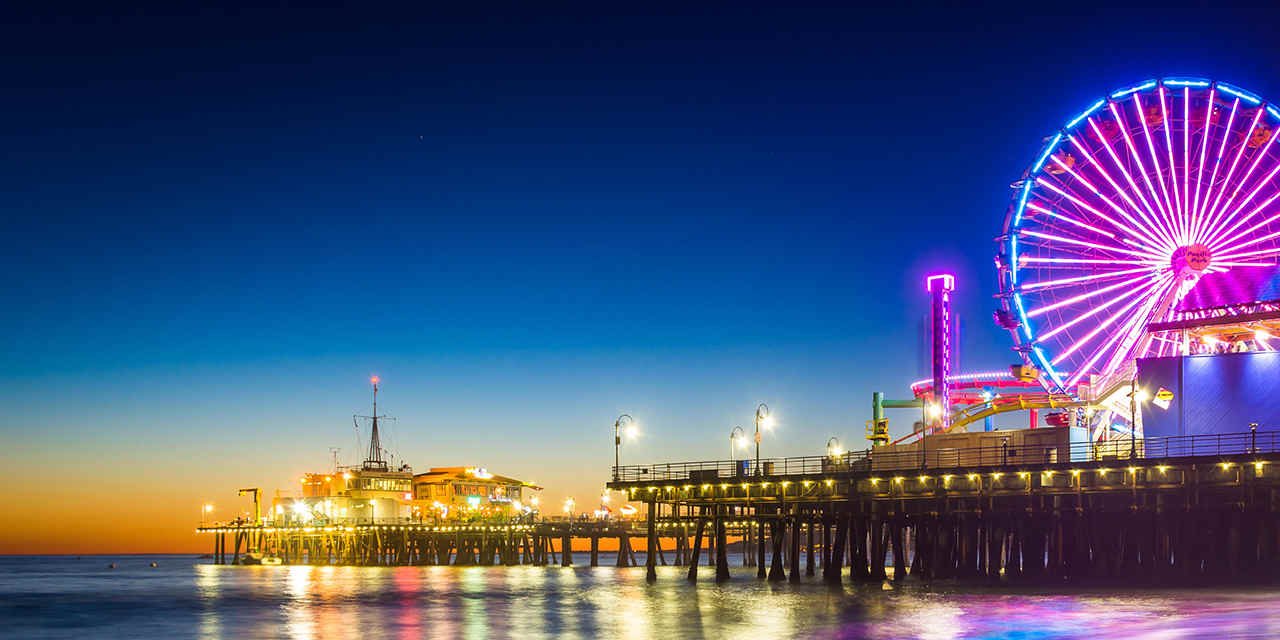in this post, we’ll cover all you need to know before traveling to Rome like where all the major attractions, what’s the best time to visit, where to stay, how to use public transportation, how much things cost, what power plugs, and outlet styles they use best apps to use in Rome, best views of the city and much other practical information.
1. ABOUT THE CITY
Rome is the capital of Italy and with a population of around three million, it is also its largest city.
Although the official founding of Rome is estimated around 753 BC, the area was inhabited long before that, and it is considered one of the oldest inhabited areas in Europe.
As a result, Rome’s city center feels like one big open-air museum and is listed as a UNESCO World Heritage Site.
Rome was built on seven hills, and the legend says that it was founded by Romulus who killed his twin brother Remus after the two of them have been raised by a she-wolf. Because of its relatively small historic center, culture, rich architecture and history, and great food, Rome is considered to be one of the best romantic travel destinations. Located within the city of Rome lies the world’s smallest independent country, the seat of the Roman Catholic Church – Vatican City.
2. THE MAP OF ROME
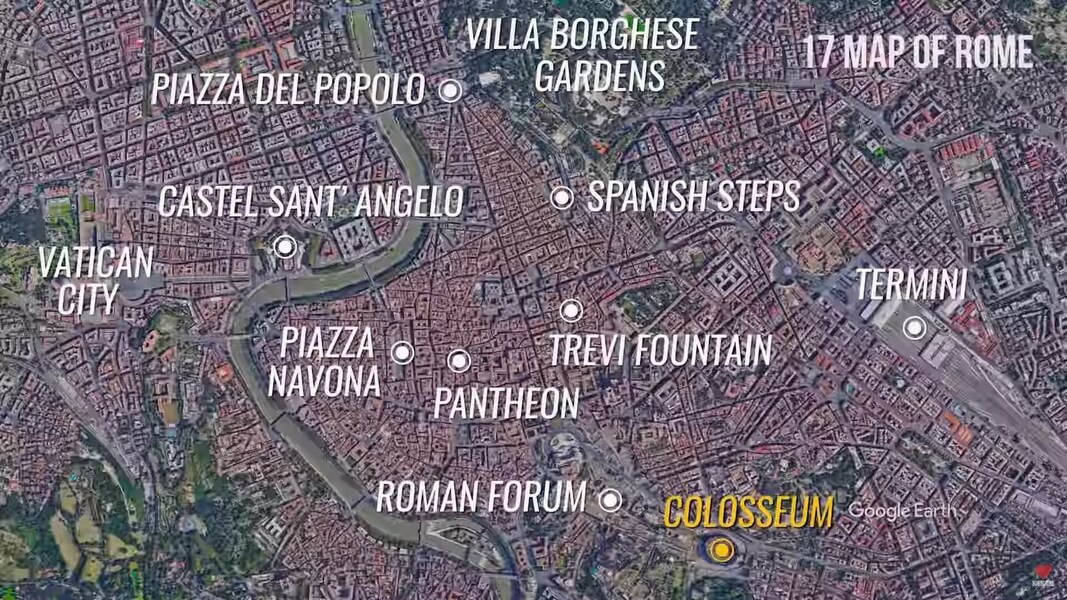
Rome is located in central Italy on the Tiber river, about 15 miles or 26 km from the Mediterranean coast.
Most of the famous attractions are located East of the Tiber river.
For orientation, let’s start with the Colosseum, which is located more or less centrally, right next to the famous Roman Forum and Altare Della Patria.
South of the Colosseum you will find, for example, Circus Maximus, the ancient chariot racing stadium and the ruins of the Terme di Caracalla, ancient Roman baths. Termini, Rome’s main train station is located Northeast of the Colosseum. If you go Northwest of Colosseum, you will find Trevi Fountain, Spanish Steps, Piazza del Popolo, and Villa Borghese Gardens right above the square.
Towards the West, you can find Pantheon and Piazza Navona and when you cross one of the beautiful bridges there, you will first see the famous Castel Sant’Angelo and finally Vatican City.
The impressive Via Appia Antica Park, with an over 2,000-year-old road featuring an assembly of catacombs, villas, and other archeological gems, is located Southeast.
To get a better sense of the distance, a 1.1 mi. or 1.8 km long walk from Termini Train Station to Colosseum takes about 20 minutes, or approximately the same distance to get from Colosseum to Fontana di Trevi.
3. WEATHER AND CLIMATE
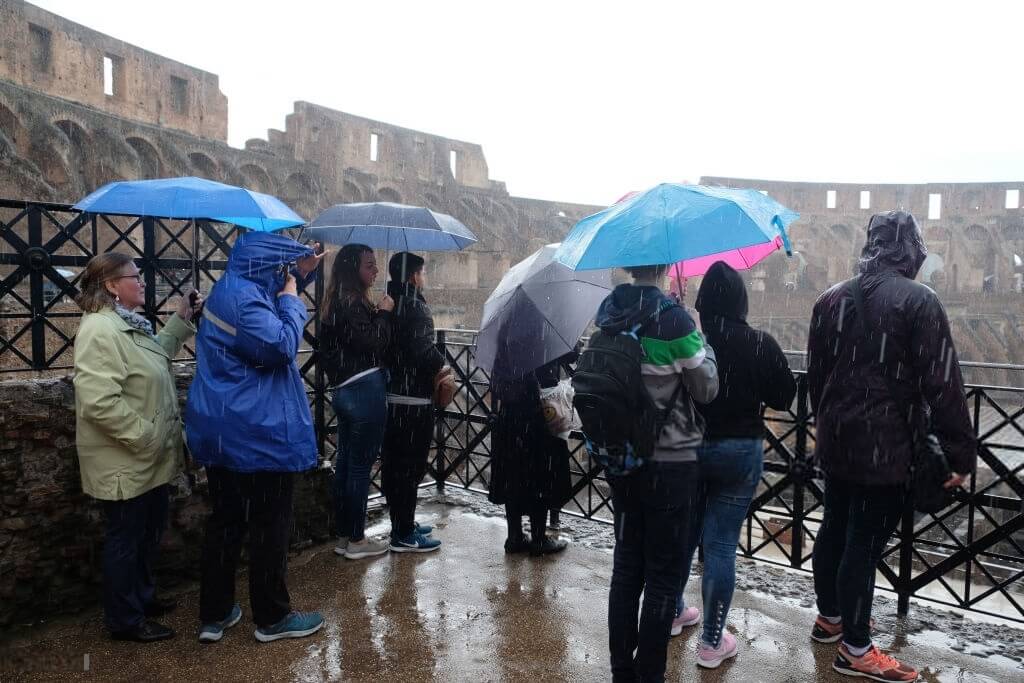
Rome has a Mediterranean climate with mild winters and hot and humid summers. Temperatures in winter typically range between 32-53 °F or 0-12 °C.
Rain is common in winter, especially in December which is also the wettest and most humid month.
Weather in the spring is unpredictable and average temperatures range between 41-73 °F or 5-23 °C.
Summers are hot and humid. The humidity is typically around 70 % with little rain, and the temperatures usually range between 60-90°F or 15-32°C.
Fall is generally nice and still warm and dry, from 44-80°F or 7-26°C.
However, these are just averages and weather can be different when you travel so make sure to check the weather forecast before traveling.
4. BEST TIME TO VISIT
The best time to visit Rome is between April and May in the Spring and September to November in the fall when the weather is cooler, it’s still pleasant to walk outside and the herds of tourists are gone. You can usually only wear a light jacket.
Probably the least convenient time to visit Rome is in August when it can get extremely hot and humid, and there are crowds everywhere. In any case, if you are traveling to Rome in summer, don’t forget to bring a hat.
And how to figure out when it’s the best day and hour to see the attractions? Just check Google to see how crowded a specific location is in certain time of day.
5. WHERE TO STAY AND PRICES
Since Rome is a relatively small city, most of the tourist attractions are in the walking distance of each other. To stay close to major attractions we recommend that you stay somewhere between the Tiber river and Termini train station. This way you will be surrounded by famous attractions, best restaurants, and a traditional Roman atmosphere.
If you want a truly authentic experience and don’t mind spending a little more, you can stay close to Piazza Navona, Trevi Fountain, Piazza di Spagna, and Piazza Barberini.
If you want to save some money you can stay a little further away from the center, however, be sure to check if there is an underground station nearby so you can easily reach the city center. The average price of a hotel room in Rome is around 130 EUR or 150 USD, however, with a little research online you can easily get a better deal especially if your dates are flexible.
6. LINES & CROWDS
Rome is a popular tourist destination year-round, and it can get very crowded, especially around major attractions, such as the Colosseum, so be prepared to wait in line or buy a skip-the-line ticket or Rome City Pass if you are willing to pay more.
7. CURRENCY
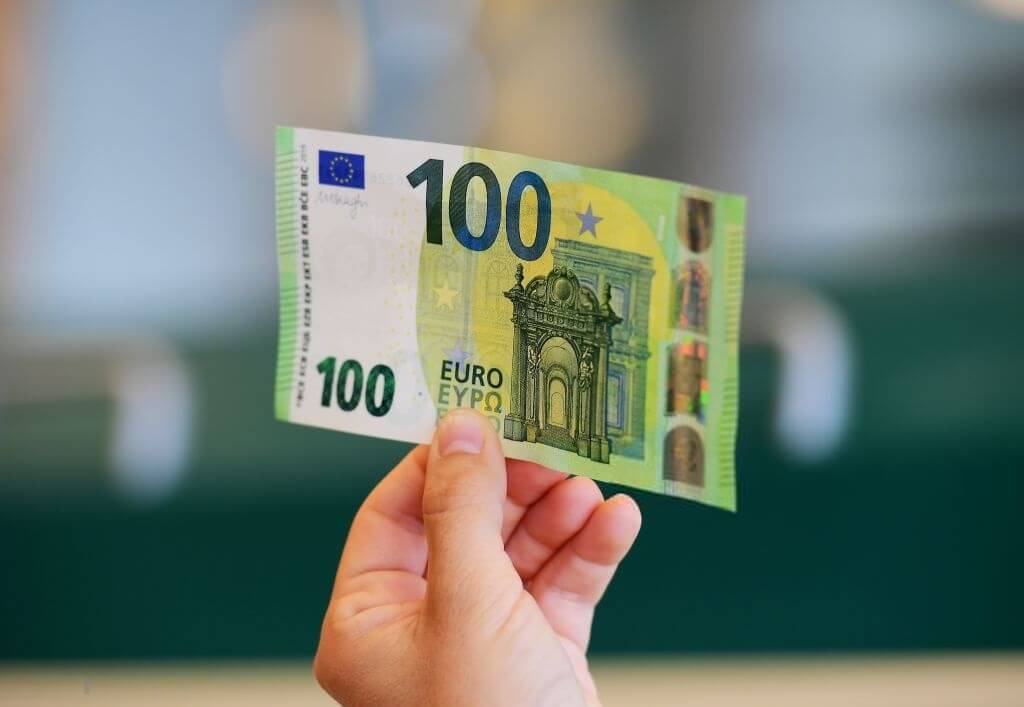
The currency used in Rome is Euro, used in most European countries, including Italy. While most hotels, stores, and restaurants in Rome accept major credit cards like Visa or MasterCard, it is always wise to have some Euros in your wallet.
8. LANGUAGE
The language spoken in Rome is, of course, Italian, specifically the Romanesco dialect. While they do not speak or understand English everywhere, most tourist-oriented places such as restaurants, shops, and major attractions will have people who speak English and sometimes even other major languages.
9. TIME ZONE
Time zone in Rome and Italy is Central European Summer Time or GMT+2. This time zone is used in most countries in continental Europe.
10. TRANSPORTATION
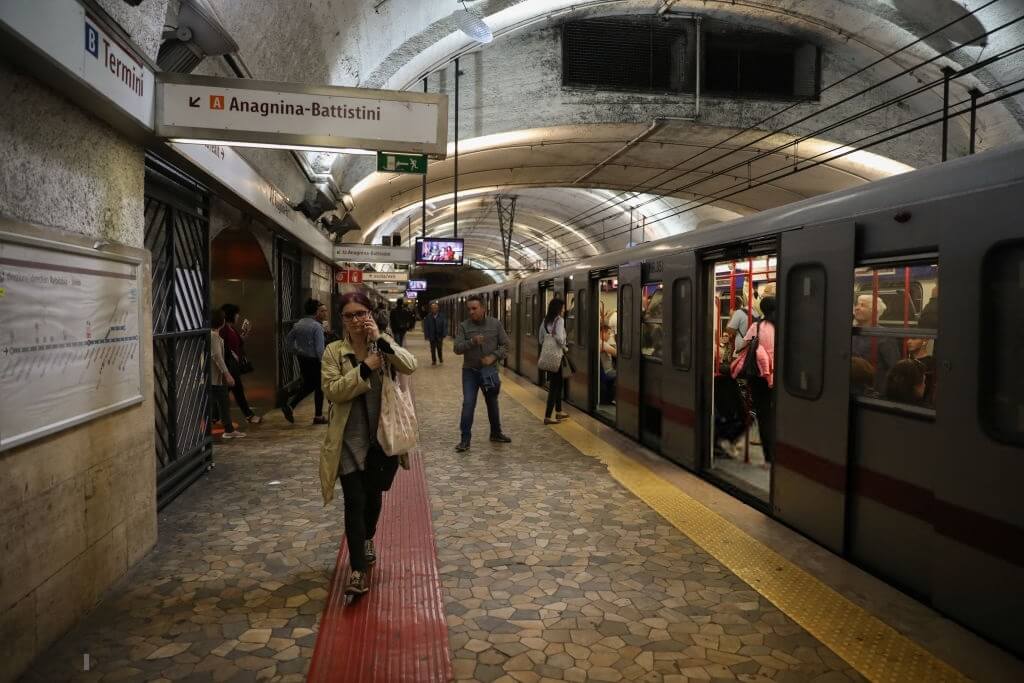
Rome has two major airports, Leonardo da Vinci International Airport aka Fiumicino, located approximately 19 mi. or 30 km from Rome’s city center and Ciampino, located approximately 9 mi. or 15 km from the city center.
To get to Rome from either Fiumicino or Ciampino airport, you can choose amongst the following options:
- Train
- Bus
- Shuttle or transfer service
- Taxi
- Car rental
However, if you are only traveling to Rome you will probably not need a car to drive around, plus many hotels in Rome charge extra for car parking, and some even don’t have parking spaces, so we only recommend this option if you are planning to drive to other parts of Italy too. Keep in mind that there are no Ubers or Lyfts in Rome, except for more expensive Uber Black, Uber Lux, and Uber Van.
Arriving by train:
If you are arriving in Rome by train, you will normally arrive at Termini railway station, which is conveniently located in the city center.
Depending on your final destination in Rome, you can check if your train also stops at one of the other major train stations in Rome.
Arriving by car:
If you are arriving to Rome by car, consider renting a hotel or an apartment with a parking space or a garage nearby. Parking in garages around and in city center costs from 1-3 EUR per hour and approximately 18 EUR per day on average. You can get a parking space on the street for approximately 1 EUR per hour.
Getting around the city:
Walking –
While Rome is relatively well covered with public transportation, certain central areas are at least about a 10-minute walk away from the first underground station. And since central Rome is not too big, walking will probably be part of your daily routine, so bring some comfortable shoes. While some areas are not covered with underground.
Public Transportation –
it is still a popular form of transportation in Rome. One-way ticket or 100 minutes on all buses costs 1.5 EUR, 24-hour-ticket costs 7 EUR, 48-hour ticket is 12.50 EUR and you can get the weekly ticket for 24 EUR. You can use the ticket machine to purchase tickets.
Bus and tram are also part of public transportation. You can use Google Maps or a similar app which includes public transportation in Rome.
Other –
There are many other forms of transportation in Rome such as Hop On Hop Off buses, bike or Vespa rentals, Segways, and other interesting vehicles you can rent.
11. GENERAL INFORMATION
Here are some things you should know before traveling to Rome to make your experience nice and easy:
Drinking water:
It is perfectly safe to drink tap water in Rome. Additionally, there are a lot of free and safe water fountains spread out across the city. And yes, some drinking fountains even offer free sparkling water.
Toilets:
There are only 7 public toilets in Rome. However, if you are visiting a museum or another attraction, there’s usually toilets available there.
Rome is also full of bars. While you can’t just walk into a bar or a restaurant and ask them to use the toilet you can order an espresso or cappuccino which will usually only cost from 1 to 2 EUR and use a toilet in a bar.
Opening Hours:
Restaurants, bars, and shops have different opening hours, and some of them are closed during a lunch break.
Some restaurants are typically closed on Mondays and some even on Tuesdays.
So always check the opening hours of the attractions, restaurants, or shops you plan to visit in advance.
National Vacation in August:
In August, many shops closed as many locals go on their vacation. In fact, it is so common that it has a name: “Ferragosto”, which roughly translates to vacation in August.
Free Attractions:
Many of the sights in Rome are completely free of charge. Since Rome is literaly an open-air museum, many of the famous sights like Trevi Fountain, Pantheon, Spanish steps, Altare della Patria, Villa Borgehse Gardens and others are completely free of charge.
12. FOR INTERNATIONAL TRAVELERS
If you’re coming from outside Europe or the UK, you will probably need a special European travel adaptor to charge your phone and other devices.
We recommend purchasing a travel adaptor before traveling to Rome. In fact, it is worth buying the adaptor for the entire world so you can use it in other countries too.
13. SAFETY
Rome is generally a safe destination, so you normally shouldn’t be worried about specific areas to avoid or staying inside at night, as long as you are on the streets in the city center.
However, typical for all major big cities around the world, pay attention to pickpockets, especially in the crowded areas close to major attractions, for example, the Colosseum. Use common sense and watch your valuables. For emergency services dial 112.
14. BEST APPS TO USE IN ROME
Your smartphone can be your best buddy in Rome. Here is the list of useful apps:
- WiFi Map or WiFi finder, which helps you find Wi-Fi throughout Rome.
- Google Maps for walking, public transportation, driving, etc. Google Maps also lets you download your map which is a great option if you don’t want to use roaming.
- Ulmon: featuring maps, including information on where to eat, drink, shop, find a hotel and sightsee.
- Civitatis Rome, which includes all the necessary and up to date tourist information about Rome, like where to eat, and other useful information.
- MiC Roma: an app allowing users to receive official news and updates in English, about current and planned exhibitions, events and educational visits taking place at the time of your visit.
- TAP / I Nassoni di Roma: with a map of free and safe water fountains spread out across Rome. There are over 2,500 of them so even if you don’t have an app you will likely find one around the corner.
- Trip Advisor and Yelp for restaurant, hotel, museum, or tour reviews.
15. FREE CITY TOURS
Walking tours of Rome are organized by professional tour guides who known great deal about the city’s rich history, legends, etc., A great way to discover Rome. Some providers even offer free walking tours.
16. ROME CITY PASS
Rome offers the Rome City Pass which is a good option to save some money if you are planning to visit several museums and other attractions and want to skip the line at some locations. You can even choose a city pass that combines attractions and public transportation, including tickets from and to the airport.
17. FOOD AND DRINKS
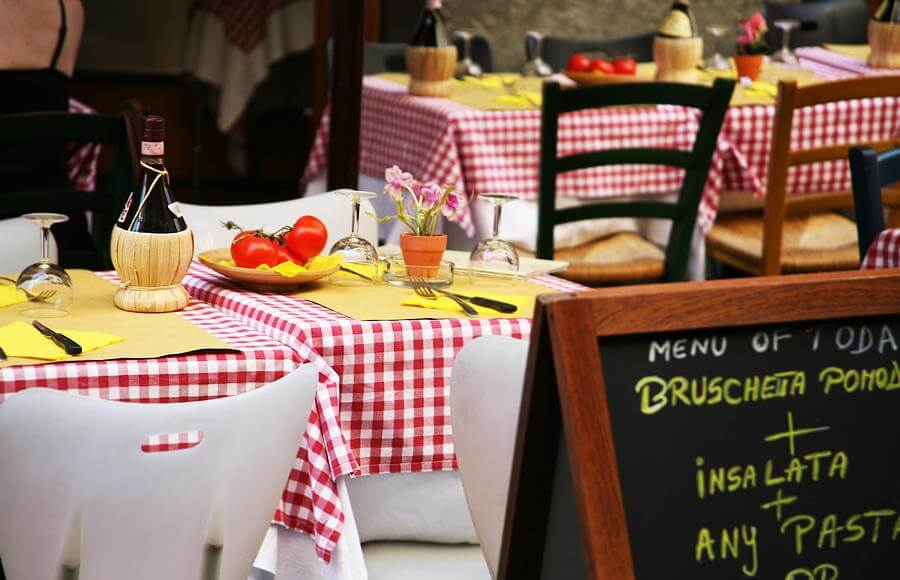
Rome offers some great restaurants. We suggest using Yelp or TripAdvisor to find a nearby place with good reviews.
Try to avoid sitting down in the restaurants next to major attractions, many times you can find a much better price/quality ratio restaurants a street or two away from the main locations.
An average price for coffee is 1 EUR for an espresso and 1.30 EUR for a cappuccino. The average price for an inexpensive to mid-range restaurant meal is 10-15 EUR for lunch and between 15-20 EUR for dinner.
Beer will typically cost you between 3 and 5 EUR and you’ll pay about 2 to 2.5 EUR for two scoops of amazing Italian gelato. There are many great cheap eats in Rome.
Tipping in Rome is not mandatory. However, some restaurants might add a service charge on top of the bill, usually around 10%, and some restaurants might bring you bread with the meal and charge you for that too.
Unlike some other places in Italy, the so-called “coperto”, or in other words, the fee for sitting down in a restaurant is illegal in Rome. You can also buy something to eat or drink in a grocery store. You can use Google Maps or a similar app to locate one near you.
18. BEST FREE VIEWS OF THE CITY
You can enjoy several amazing views of Rome:
Altar of the Fatherland: Located in the center of the city with great views in all directions.
Terrazza del Pincio: A platform stretching directly from the beautiful gardens of Villa Borghese, located above Piazza del Popolo.
Janiculum Terrace: A terrace located on a hill just behind Vatican City.
